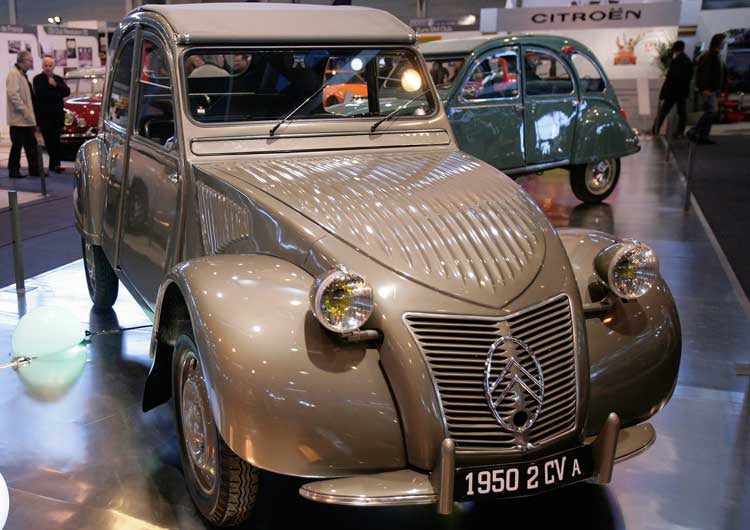Citroën 2CV
Brian Sewell on his love of the Gallic workhorse that took the world by storm

Citroën's Deux Chevaux is more a car of myth than any other. In philosophical terms it is Corbusier's vehicle, the fitting accoutrement to the blocks of flats that he designed as "machines for living". Corbusier, of course, had no hand in this or any other Citroën, but he did design a Voiture Minimum that shares fundamental styling cues with the 2CV.
Citroën's Deux Chevaux is more a car of myth than any other. In philosophical terms it is Corbusier's vehicle, the fitting accoutrement to the blocks of flats that he designed as "machines for living". Corbusier, of course, had no hand in this or any other Citroën, but he did design a Voiture Minimum that shares fundamental styling cues with the 2CV.
In 1935, Corbusier's design was entered into a Société des Ingénieurs de l'Automobile competition that was staged to revive a French motor industry dominated by the luxury trade. The aim was to create a car for the people that would sell for half the price of conventional vehicles and average 50mpg at 50mph.
There is little doubt that Pierre-Jules Boulanger, another architect and by chance the head of Citroën, knew of Corbusier's ideas when the concept for the 2CV was completed in 1936.
Boulanger's brief to his designers was more specific than that of the SIA competition; the minimal Citroën was to be "an umbrella on four wheels'' that would appeal to the French farmer. It was to seat four men and carry the weight of a fifth in luggage, and be capable of transporting any animal or crop, its suspension so soft that a dozen eggs would survive on the back seat were the car to be driven over a ploughed field at 30mph. Its maximum speed was to be little more than that - perhaps 40mph - and its fuel consumption a parsimonious 90mpg.
By the beginning of 1937 the first prototype was on the road. It appeared to have been designed by a child with a pair of wonky compasses, then cut from sheet metal with blunt shears. The front of the car was made of corrugated aluminium, its grotesque nose vaguely resembling the Chrysler Airflow. Having only one headlamp did nothing to ameliorate its ugliness, nor did the permanent sprout of its starting handle.
Its canvas roof reached from above its flat windscreen down to the rod that passed for a rear bumper. Beneath the bonnet lay a BMW 500cc motorcycle engine and beneath that a suspension system that did not protect the eggs. Ramshackle was the only word to describe it. Not until early in 1939 were its many problems ironed out, with the whippy sub-frame reinforced and the suspension replaced, but the engine remained the same. Around 250 cars were ready for the Paris Motor Show, but the event was cancelled when war broke out. After the fall of France in 1940 all but one of the cars was destroyed. Citroën engineers continued to tinker with the survivor, and the 2CV was introduced at the first post-War motor show in 1948.
Pressed steel replaced the previously aluminium body and most of the corrugated metal disappeared. The suspension was a brilliantly simple system that kept all four wheels in contact with the road while the passengers experienced a yacht-like yaw; the engine was replaced by an air-cooled horizontally opposed two-cylinder unit of only 375cc that was designed and built by Citroën; and the gearbox now had four speeds. To those who knew the pre-War prototype, the new car was an ugly duckling turned swan, but those who did not reacted with disbelief.
But Boulanger had been right in his thinking. French peasants loved it; it did indeed rattle its way across ploughed fields yet did not break the eggs, it took the fattened pig to the abattoir and Madame to church. It was immediately comprehensible to local handymen and could be hosed clean inside and out. To men who could never have aspired even to own a Peugeot, its crude looks were part of its appeal, for it was, above all, an agricultural tool.
The urban French saw virtue in it, too, as the perfect car for traffic jams, to be bashed, battered and abused. The initial price in France was £212, undercutting all other four-door saloons, and it also sold well across poverty-stricken Europe. Only in Britain was it derided - Autocar called it "the work of a designer who has kissed the lash of austerity with an almost masochistic fervour''. For six years from 1953 it was made in Slough, but we never warmed to it. The Germans did, though, and even in its last full year of production, 1989, bought 7,866 of them. The 2CV has some claim to have been a World Car, built, as it was, at plants from Iran to Argentina and Madagascar.
No Alpine pass ever stopped it, nor shifting sands in the Sahara. With a plastic body it became the Mehari beach car; with two-tone Art Deco paint-job it became, as the Charleston, the cult car of California. Its engine capacity increased in stagesto 602cc, its power from nine to 29bhp, and its top speed from 40 to 75mph (at which its interior noise level reached 80 decibels).
With a second engine in the boot it became the must-have car for the Paris-Dakar rally, and without a body at all it almost became the brilliant Africar, the vehicle that could have changed the lives of almost every African. If I had to nominate one car from the past 50 years capable of the greatest good, it would have to be the Deux Chevaux.
Subscribe to Independent Premium to bookmark this article
Want to bookmark your favourite articles and stories to read or reference later? Start your Independent Premium subscription today.

Join our commenting forum
Join thought-provoking conversations, follow other Independent readers and see their replies